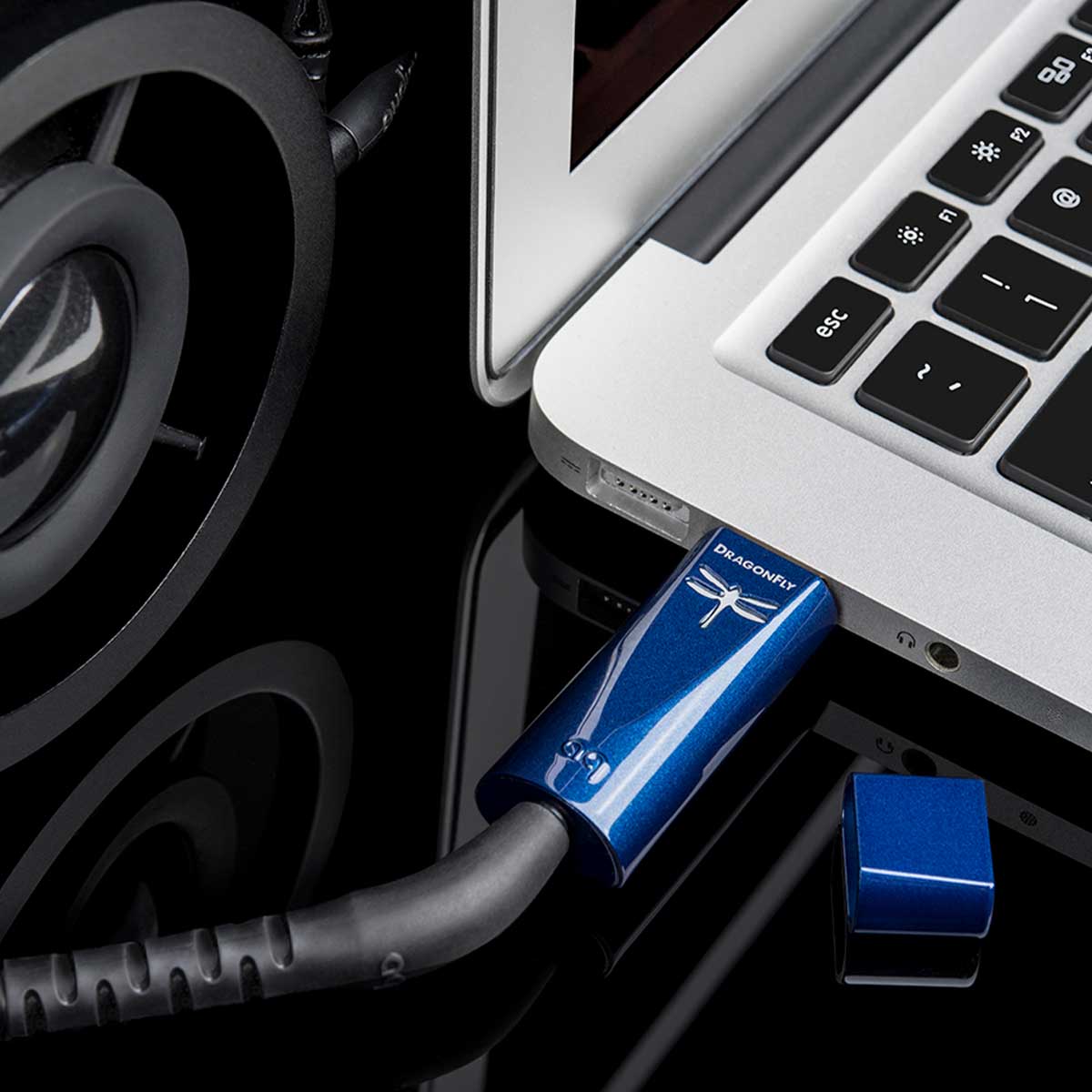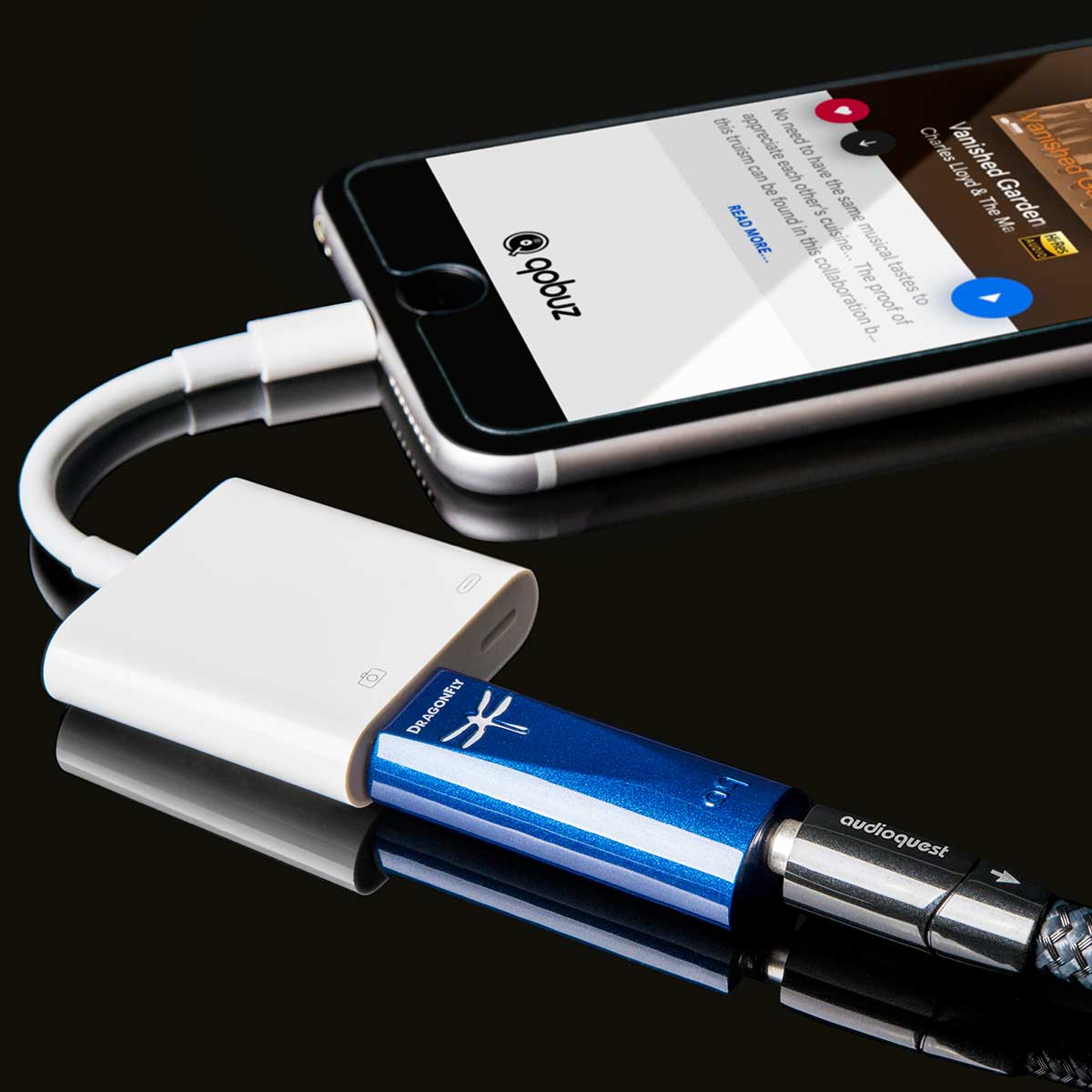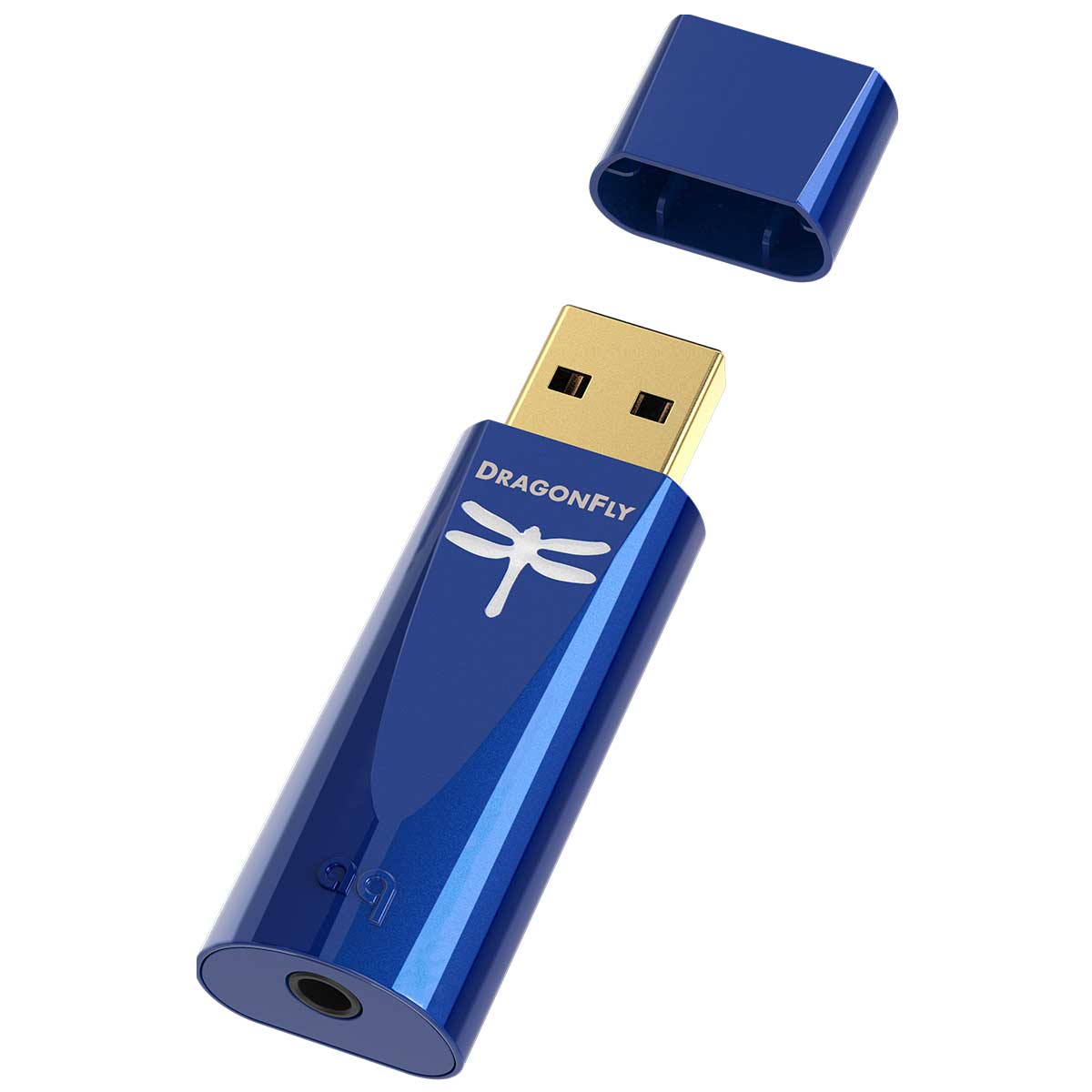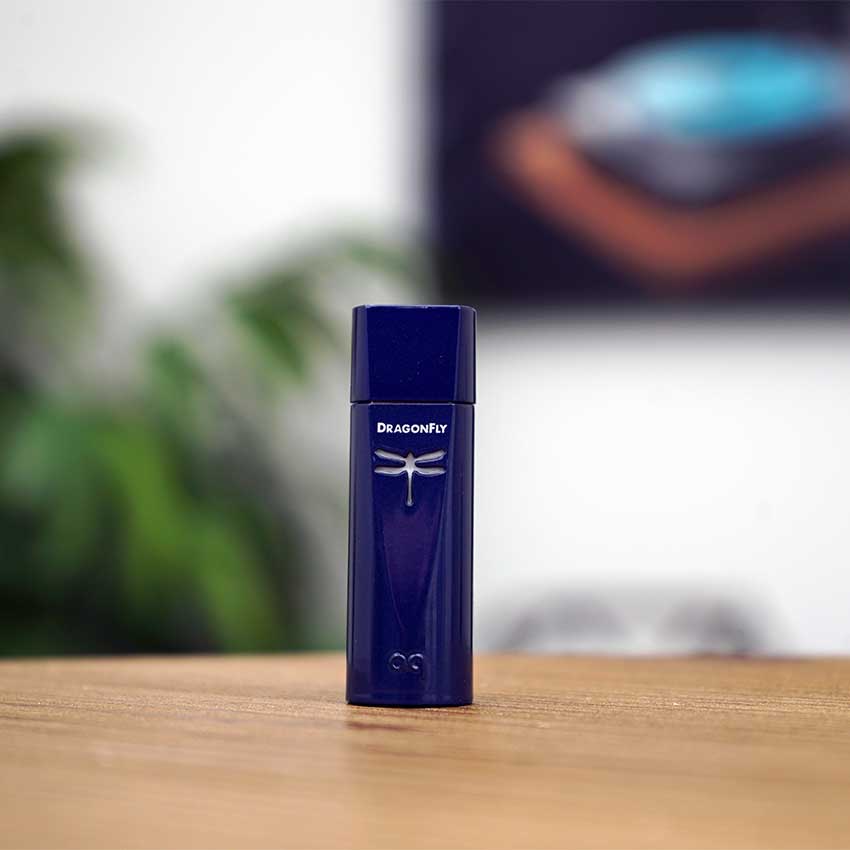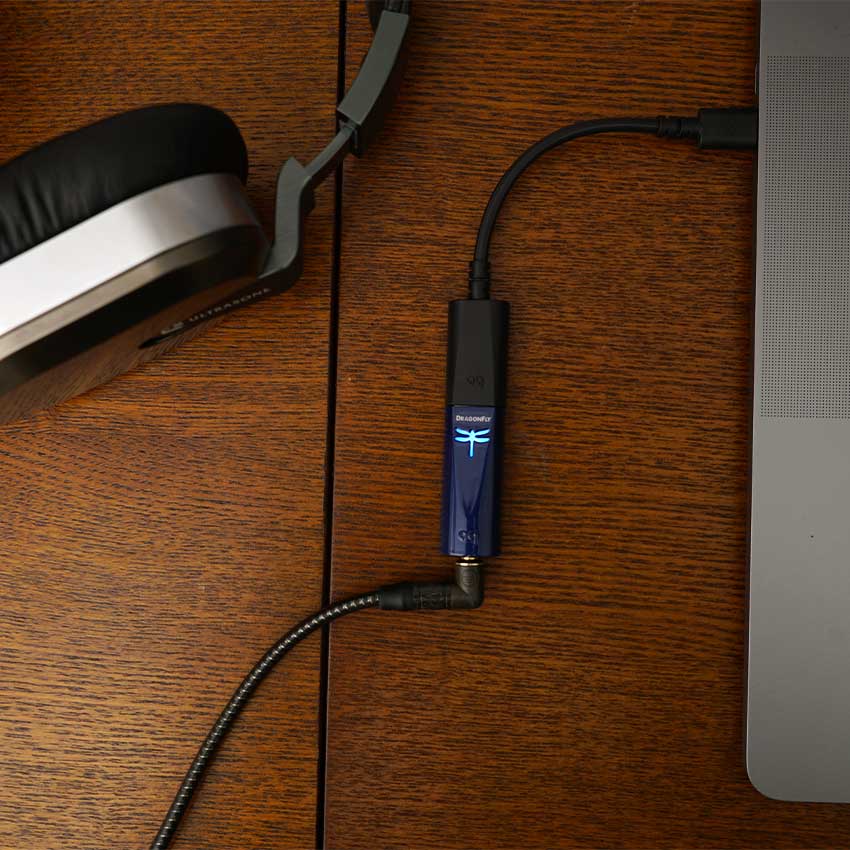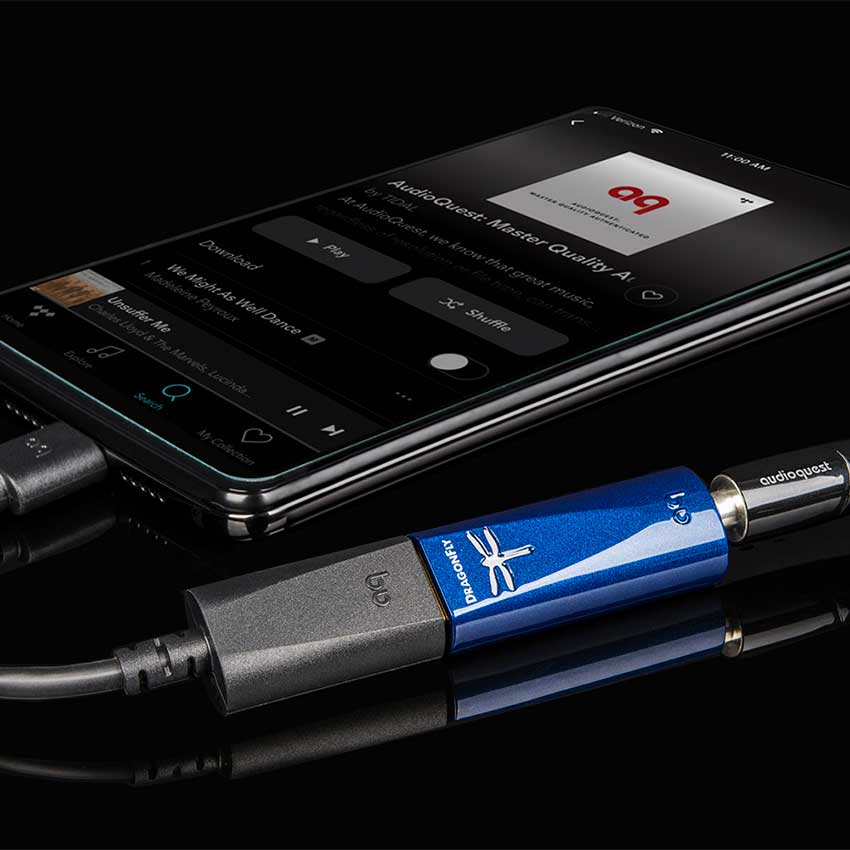AudioQuest DragonFly Cobalt
AudioQuest DragonFly Cobalt
Couldn't load pickup availability
Free Shipping On All Orders, No Minimums.
We offer free 2-day shipping on most products within the continental US.
Weekdays - Orders placed by 2pm EST ship same day. Orders placed after 2pm EST will ship the following business day.
Weekends - Orders placed on Saturday and Sunday will ship Monday.
Orders requiring motor freight delivery may take more than two business days. Once your order has shipped, you'll receive a shipping confirmation email with a tracking number for easy tracking.
Orders that contain items that are currently backordered, special order, or out of stock will ship complete once all items are in-stock unless otherwise requested.
If you need it faster, you will have the option of choosing a quicker shipping option when you checkout on the website.
At this time, we do not ship internationally and orders to Hawaii and Alaska may incur an additional shipping charge. Please contact us at 888.899.8776 or email support@audioadvice.com to confirm.
Rerouting and Address Changes
We cannot make ANY address changes once an order is placed. If you are unable to accept delivery of your package as ordered, we will need to cancel your order, return the package to sender and have you replace your order through our website.
Keep the Box
We suggest you keep the shipping box or boxes for at least 30 days. It is actually a great idea to keep boxes for audio products for the life of the product. Having the box and all packing will increase the trade-in value should you decide to move up and they are handy to have should you ever need to send the unit in for repair.
How To Receive a Motor Freight Order
The trucking company will contact you to schedule a convenient time to deliver the order. Please note that you must be present for delivery.
Visually inspect the box to make sure you see no signs of damage. If you notice any damage at all, take some pictures with your phone and make a note of them on the delivery receipt the driver will ask you to sign. If it is obvious that the product is damaged, please refuse the order and contact us immediately at 888.899.8776 or email support@audioadvice.com.
Open your box as soon as possible and inspect the product for damage and contact us if you find anything wrong.
uShip In-Home Delivery
Due to current concerns surrounding COVID-19, uShip is able to offer THRESHOLD SERVICE ONLY at this time. To ensure everyone’s safety, uShip is advising carriers to refrain from making room-of-choice deliveries. Threshold service consists of the shipment being brought into the first door of the address or the lobby of an apartment/condo, and does not include set-up, installation, assembly or debris removal.
What to Expect: Most oversized items will be delivered within 2-3 weeks. Your carrier will place your item inside the first door of the address or the lobby of an apartment/condo.
Appointment Scheduling: Your delivery partner will call 24-48 hours prior to delivery to arrange an appointment window.
How to prepare for in-home delivery:
- Determine the clearest path from the street to your home
- Measure entrances and hallways to ensure your item will fit
- Remove any wall hangings or clutter to ensure a clear path and to prevent damages
- Remove old furnishings to allow placement for your new piece
Check your furniture for damages: We rarely expect damaged furniture, but in the instance it does happen, we have you covered. Once your item’s packaging is removed, check for any damages that may have occurred in transit. Take pictures of any damages and notate appropriately on the delivery receipt. Keep possession of the damaged piece and contact us via phone or email and we’ll start the process to repair/replace your new piece of furniture. For uShip customer support, please call 800-698-7447.
At Audio Advice, we pride ourselves on customer satisfaction. We'll bend over backward to make sure you're 100% satisfied and we won't accept anything less. We offer 30-day hassle-free returns and personalized service from real, live people.
If an item doesn't meet your expectations, you may return or exchange it in its original condition and packaging within 30 days for a full refund, minus shipping fees. Items shipped back in like new condition through standard shipping carriers will only incur a flat fee of $15 to return. If the items were initially shipped through free scheduled delivery via motor freight (commonly referred to as LTL), returning them will result in return shipping fees starting at $150. These items include but are not limited to, oversized items such as TVs, certain subwoofers, floorstanding speakers, furniture, and most items weighing over 75 pounds. Return fees will also apply for exchanges. We want to treat your system as if it is our own and want you to be completely satisfied with your purchase.
Please see the instructions below. We only accept returns for any product purchased directly from our website. If merchandise is not returned in its original condition or is missing packaging, manuals, accessories or other parts, or the resale value of the product has been impaired, a partial refund will be given and calculated on a case-by-case basis.
Non-Returnable Items
The following items cannot be returned or cancelled:
- Special/Custom Order Items
- Open Box Products
- Gift Cards
- In-ear headphones cannot be returned once the packaging has been opened due to personal hygiene reasons. Please contact our customer care team if you'd like help choosing.
-
Turntables With a Broken Stylus: All turntables ship out with the stylus intact. If you return a turntable or phono cartridge with a broken or missing stylus you will be subject to a return fee. Please be careful when setting up your turntable and contact us with any questions.
Is It Easy To Return An Item?
Yes, simply give us a call at 888.899.8776 or you can email our support team at support@audioadvice.com. Many times our team of experts can help figure out why the product might not be working like you expected and get things fixed over the phone, so don’t be surprised if we ask a few questions, we love troubleshooting!
If our tech help can not make you happy, we will email over a return shipping label with a Return Number.
Hopefully, you saved all of the original item’s box and packaging inserts. You will want to pack back up your return or exchange in the same way it came out of the original box. Once you have everything packaged correctly, tape the box on the top and bottom to assure it stays together. If Audio Advice shipped the item to you inside a second box, it's a good idea to use that same extra box to help prevent damage on its way back to us. To avoid it accidentally coming back to you, use a magic marker to cross out the old shipping label or just tear it off.
The return shipping label we send you will have our address on it, just make sure you take the box to the right shipper (UPS, FEDEX, or USPS) as per the label.
If you are close to one of our stores, please let us know if it is more convenient for you to return it to us directly. You will still need to get a return number by contacting us and shipping and/or restocking charges may apply.
When Will I See My Refund?
It usually takes around 7-14 days for the refund to show up on the payment method you used. We do inspect all returns for damage and accuracy of the item inside the box before issuing a refund. Some items may be subject to shipping and restocking fees.
Can I Exchange My Purchase For Something Different?
Sometimes those big speakers just don’t fit in the room or you might have bought a small subwoofer and later found out you’d love a bigger one. If you would like to make an exchange within 30 days of receiving your item, just give us a call at 888.899.8776 or email support@audioadvice.com and we will help work out the details. Additional shipping charges and return costs may apply.
How Do I Cancel An Order?
If the item has already shipped out or is a special order item, it is not possible to cancel the order. Please contact us at 888.899.8776 or email support@audioadvice.com to start the return process.
What If I Find Shipping Damage?
We need to know right away about any shipping damage. Please contact us at 888.899.8776 or email support@audioadvice.com within 48 hours of your delivery so we can get the ball rolling on making things right. It’s very helpful to take some pictures and email them to us if possible.
Can I Refuse A Shipment?
You can, but unless the item is damaged, shipping and restocking fees will be deducted from your refund. If your item arrives damaged and you are lucky enough to be there, snap some quick pics and refuse the order. Then contact us so we can get a replacement on the way.
What Happens If My Order Is Defective?
This is actually pretty rare, most consumer electronics work fine out of the box 99.9% of the time. We’d like for you to contact us first by calling 888.899.8776 or email support@audioadvice.com so we can help get to the bottom of things. If your item is indeed defective during the first 30 days, we can usually exchange it for a new, replacement unit.
What About Service After 30 Days?
Audio Advice has a great relationship with all of our brands and can help you with warranty service by the brand after our 30-day guarantee period. Even after the warranty expires, we can arrange for service by the brand on products purchased from Audio Advice. Just call 888.899.8776 or email support@audioadvice.com.
How Do You Determine A Restocking Fee?
You may not believe it, but sometimes we receive items back that were put in the box with zero packaging and are completely destroyed or are missing many of the pieces that came with the item. We also track serial numbers and will get back different serial numbers. We’ve even seen different items than what we shipped out be returned. However, it’s very important to package your return properly so that nothing goes missing or gets damaged in shipping, which will result in a restocking fee or even no refund at all. If a product is opened and the market value of the product is reduced, then a restocking fee may be applied to the cost of restocking and the reduced market value of the product. The bottom line is if you treat us fairly, we will do the same.
Audio Advice strives to provide industry-leading support and service while also maintaining the lowest prices available on products for our customers. We work hard with our vendors to bring our customers the best products at each price point. As a part of that process, we work with our vendors to provide the lowest pricing in our stores and on our website.
Our prices should always be the same as any other authorized dealer, including big-box retailers and major online retailers.
If you believe that you have found a lower advertised price from a legitimate authorized seller, call us and let us know so we can make sure we can correct any inadvertent error on our side. As a matter of policy, we update our prices automatically if a vendor changes its authorized pricing policies, so we generally have the best prices all the time. Increasingly, there are knock-off copies of products online, usually sold by non-authorized dealers.
Please be sure that the item meets the following conditions:
- The item is brand new, in stock, and available for purchase
- The item has the identical model number, color, etc as the item on our site.
- The seller is an authorized dealer
As always, our goal is to provide a terrific customer experience, including industry low prices. We appreciate your support.
Overview
The High Notes
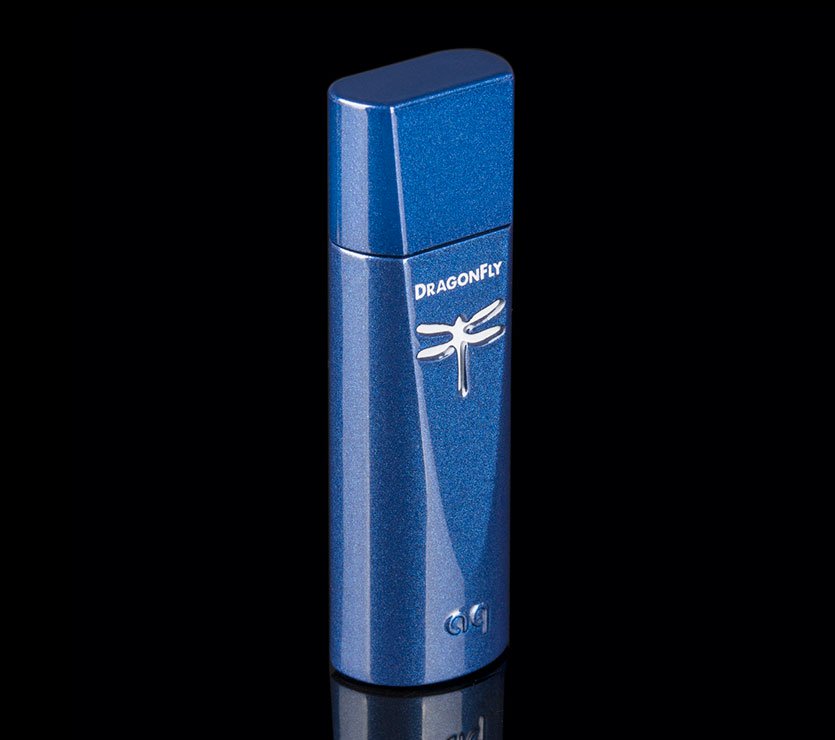
Gordon Rankin Design
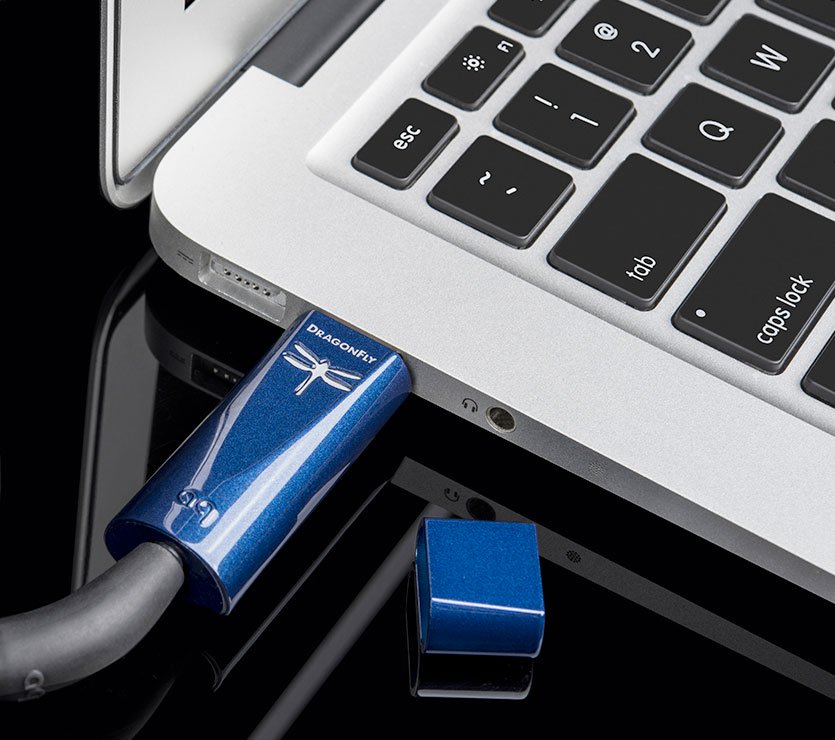
Transform Your Computer Audio Experience
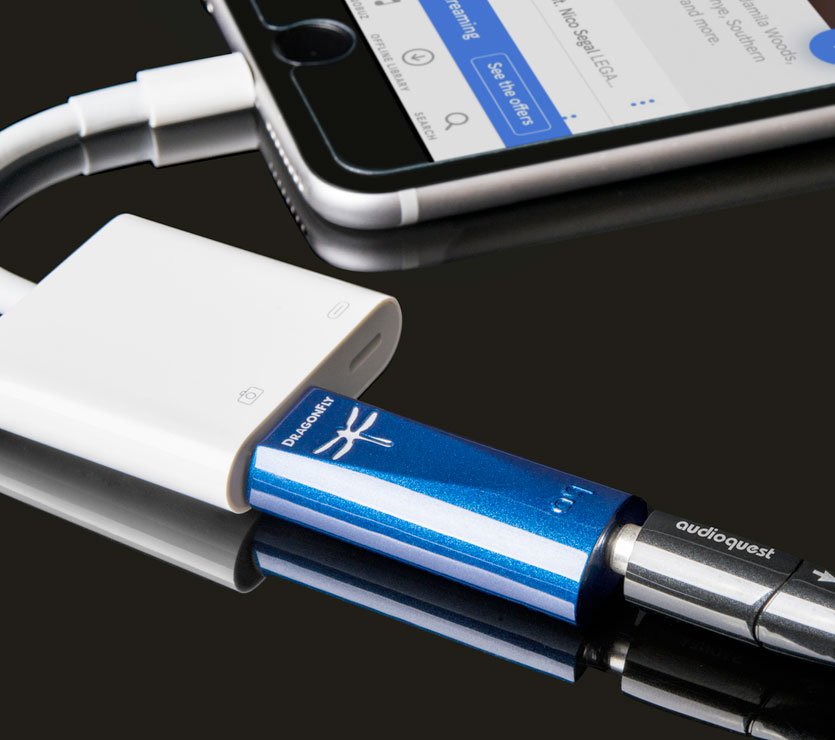
High-End Components in a Tiny Package
Company & Product Overview
At Audio Advice, we have been fans of AudioQuest products for almost 40 years. Bill Low, the founder of AudioQuest, is a huge music lover who constantly pushes the AudioQuest team to innovate to improve sound. As a very successful company, AudioQuest has a decent-sized sales force tasked with traveling around the country to see their dealers and attend consumer shows.
When computer music started to become popular, their team, who is also made of up hardcore music lovers, stored lots of music on their computers but did not have an easy way to get better sound while on the go. You certainly don’t want to carry around home components when traveling. AudioQuest felt something tiny that could improve computer audio sound would fill a huge void in the audio market. This is actually what led to the creation of the original AudioQuest DragonFly in 2012.
The DragonFly is a small and portable audio component that connects directly to a USB port. It serves as a Digital to Analog Converter (DAC), headphone amp, and a preamp. It won Stereophile's 2012 "Computer Audio Component of the Year" and 2012 "Budget Component of the Year;" Tone Audio's 2012 "Digital Product of the Year;” Computer Audiophile's 2012 "Computer Audiophile Product of the Year." That was quite a feat, but the tiny but powerful DragonFly certainly deserved it! The original DragonFly was replaced with a DragonFly Black and DragonFly Red.
The AudioQuest DragonFly Cobalt, featured in today's review, is the latest addition to the DragonFly family and promises to be the best sounding little bug yet!
Design & Build Quality
If you are not familiar with the DragonFly family, the units look like a slightly oversized USB stick. They have a male USB connection that plugs directly into your computer or with an adapter to connect to your smartphone or tablet. They are powered off the USB connection so there is no need for a power cord. On the other end is a mini-plug output that allows you to connect up to a pair of headphones or with a cable, plugs into an audio system or powered speakers.
Inside the DragonFly is a USB DAC that bypasses the DAC in your computer or phone while greatly improving the sound. The output of the DragonFly is also far more powerful than the headphone jack on a computer or phone which helps your headphones really come to life. This tiny package will give you a remarkable improvement over the sound coming directly out of your laptop or smartphone.
While the parts inside the Cobalt come in from all over the world, all DragonFlys are assembled in the United States at an AudioQuest facility in Ohio.
The build quality of the DragonFly family has improved with each new version and we have to say the latest Cobalt model appears to be even better. It’s slightly smaller than the previous models by about 10% making it even more friendly for your pocket or laptop bag. The Cobalt’s blue sparkly automotive finish is very sharp looking and we love the way the little DragonFly logo changes color while plugged in to show you the status of the unit.

Features & Technology
When AudioQuest set out to make the original DragonFly, they worked with Gordon Rankin on the design. Gordon is the founder of Wavelength Audio, the first company to improve computer audio with his USB DACs. Gordon is a brilliant designer of digital audio and is considered by many to be the inventor of asynchronous USB. Every one of the DragonFly models has featured his designs and he was up to the challenge with a slightly higher budget to make the new Cobalt even better than previous models.
For a side-by-side comparison of all the models in the DragonFly family, watch our DragonFly DAC Comparison.
Both the AudioQuest DragonFly Red and AudioQuest DragonFly Cobalt feature a very powerful headphone amplifier. Capable of 2.1 volts of output, it will drive any pair of headphones on the market with ease. Interestingly enough, 2 volts is the same output a CD player typically has which means you can connect the AudioQuest DragonFly Cobalt from your computer to an audio system and its output would match that of a CD player. Two volts are also plenty to drive any power amp, enabling you to use the Cobalt as a preamp into either a power amp or pair of powered speakers.
Having enough output checks off one box, but being able to control it with zero noise is an entirely different challenge. The Red and new Cobalt both use a bit-perfect digital volume control which has an extremely high signal-to-noise ratio (this means it’s quiet!). It also works seamlessly with both Apple and Android.
AudioQuest gives you one of their DragonTail adaptors with the Cobalt which makes connecting up to an Android USB-C connector super simple. For an Apple device, AudioQuest recommends a Lightning to USB 3 adapter.
The technology inside the Cobalt is simply amazing! Gordon and the AQ team have crammed in almost 200 components inside the tiny case. While the DragonFly Red was spectacular for its price point, the new Cobalt has several improvements over the Red.
First, the DAC chip used in the AudioQuest DragonFly Cobalt is the ESS ES9038Q2M DAC. This is a higher performance DAC than the Red and has a minimum-phase slow roll-off filter. Think smoother, more natural sound.
The processor is also improved. Not only is it 33% faster than the Red, but it has also reduced the current draw from the USB connection. AudioQuest also studied the noise from WiFi, Bluetooth, and cell phones that the DragonFly encountered while sitting very close to a cell phone or laptop. They found if they reduced this noise, the audio improved, so they decided to put more power supply filtering into the Cobalt to reduce noise.
In terms of audio file playback capability, the Cobalt can handle up to 24-bit 96Khz files and for MQA lovers, it is a full render.
The colors of the dragonfly logo will show the status of the unit. So, with just a glance, you can see what sample rate your little blue bug is streaming. The Cobalt's LED lights up with different colors indicating standby mode or sample rate: Red equals “standby-mode” — Green: 44.1Khz — Blue: 48Khz — Amber: 88.2Khz — Magenta: 96Khz. It’s that easy!

The Cobalt uses Gordon Rankin’s StreamLength®asynchronous-transfer USB code. Rather than using multiple clocks, Cobalt uses his monoClock® technology. This ultra-low-jitter clock is generated from the ESS ES9038Q2M DAC chip and runs the ESS chip functions as well as all microcontroller functions. While that is a mouthful of tech, what your ears will hear is a big improvement in both clarity and resolution of low-level audio information getting you more involved in the music.
For audio geeks, technology is always fun to talk about, but the proof is in the listening. We had heard through the grapevine from a couple of people that had listened to the prototype that the Cobalt was spectacular which made us want our initial sample to get here sooner!
Both StreamLength & monoClock are registered trademarks of Wavelength Audio, ltd.

Performance
We decided part of our testing should be comparing the AudioQuest DragonFly Cobalt to the DragonFly Red, and why not!
For most of our testing we used the Audeze LCD-3 headphone, the Audeze LCD-X, and on the more modest end the Grado Sr-225e. Ranging in price from just under $2000 a pair to just over $200 a pair, this gave us a wide range to test with. The LCD-3 is a bit hard to drive, but the other two are easy to drive. Our source was Tidal on a Windows PC. We immediately found the Cobalt had no issue at driving the LCD-3, at about 35% the volume was at what we would consider a high level.
We then set about listening to lots of different music and flipping between the Red and Cobalt. Some of the tracks we listened to were Tom Petty’s “Mary Jane’s Last Dance”; Keb’Mo’ has a great new album out called Oklahoma and we used the title track from it; another was Caroline Spence’s new album, Mint Condition where we used the track “Angels or Los Angeles”; and rounding out some classic rock, “You Can’t Always Get What You Want” from the Rolling Stones.
Our first listening was done on the Audeze LCD-3 and on the first few notes, we could tell the AudioQuest DragonFly Cobalt is really good. We tapped our toes all the way through “Mary Jane’s Last Dance”. Switching over to the DragonFly Red was very interesting. Every now and then you’ll hear a component that not only makes everything sound clearer but at the same time you get a lot more warmth and harmonic richness to the sound. It was like wiping away a layer of grunge off a window to see all the subtle colors of a beautiful sunrise. This is what the Cobalt did to the Red. Another aspect we noticed was improved rhythm and pacing on the Cobalt. We just got more into the music.
On both the Keb’Mo’ and Caroline Spence cuts, all of the instruments were separated much better, letting you pick one out and hear every nuance. We tested some deep bass passages and we feel they are very similar in their ability to produce very deep bass, although the Cobalt still sounded cleaner overall. The guitar on the Caroline Spence cut was just flat-out more harmonic and much richer sounding. This AudioQuest DragonFly Cobalt DAC is really good!
We thought when we went to the $225 Grado SR225e, we would not be able to tell as big a difference, but were proven wrong. We compared the song “Angels or Los Angeles” and immediately heard an improvement over the DragonFly Red. Much better separation and harmonic details. Same with the LCD-X. We heard big differences every time we switched between the two.
After a couple of hours of listening, we have to give Gordon Rankin and the AudioQuest team a big round of applause for coming up with such a great product as the DragonFly Cobalt!
If you own a DragonFly Red and have a decent set of headphones or a good system you are running it through, you might want to find a friend who needs a good portable DAC and upgrade your DAC to the new Cobalt.
AudioQuest is also sweetening the deal on the first 10,000 Cobalts sold. They will come packaged with vouchers for trial subscriptions to some great music-streaming services – two months in the case of Tidal and one month of Qobuz.
Want to know more about upgrading your computer audio setup for even less? Watch our DragonFly DAC Comparison where we compare the other USB DACs in the DragonFly family. We think the flagship model, Cobalt, sounds the most beautiful, but for less than $100, you will feel really good about getting the entry-level DragonFly Black or mid-level DragonFly Red.
Overall Recommendation
The AudioQuest DragonFly Cobalt is a very special portable or at-home DAC for only $299. If you have a DragonFly Red or Black or the original DragonFly, you will love the improvements, especially if your headphones or system are of decent quality. Don’t get us wrong though, the Red and Black are great products, but it's like we said earlier, once you hear the difference, it's hard to go back.

































